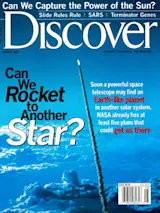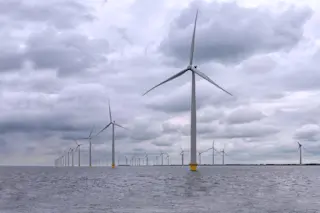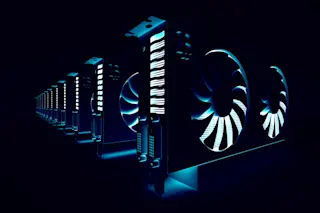Bill Gross was just 15 when he built his first solar dish, a parabolic mirror four feet across. "I boiled water with it. I cooked hot dogs. I don't know what I was thinking." Now he is 44, the president of Idealab in Pasadena, California, and he knows exactly what he is thinking: Solar dishes could be the best way on Earth to produce energy. The reason solar power hasn't delivered on its promises so far, Gross says, is because engineers have been too focused on making electricity from the light of the sun, in photovoltaic cells. He thinks the real answer is to make electricity not from the sun's light but from its reflected heat. So on this glorious sunshiny day at Idealab, engineer Denes Zsolnay and industrial designer Gregg Luconi are outdoors fussing over a six-foot solar dish. Wearing welder's masks to protect their eyes, they focus a beam of sunlight on a black stainless steel cup, known as a hot cup. They watch as a digital thermometer measures the air temperature in the cup. It begins to soar, passing the melting point of tin (450 degrees Fahrenheit) in a matter of seconds, then lead (621°F), then aluminum (1,220°F). As if to drive home the point, Luconi grabs a scrap of lumber, a two-by-four, and jabs one end at the cup. In a heartbeat, the board erupts in flame. This is more than a reconfigured schoolboy's trick. The two men and their mirror are part of a small team at Idealab building a device that uses concentrated heat from the sun to generate solar electrical power both reliably and cheaply. "We want to do something disruptive, something that's affordable right away," Gross says. They are not alone. Since 1998, Sandia National Laboratories has been experimenting with huge 28-foot solar-dish systems that produce heat, three at its headquarters in New Mexico and another at an Arizona army post. Linked to a Stirling heat engine, which drives a generator, each dish can pump out 10 kilowatts of power. The drawback is that the cost of manufacturing one "dish engine" system is about $50,000. "They're talking about something enormous," says Gross, "something so big that it has to be anchored in concrete. I wanted to make something small enough to ship in a box, something a contractor could attach to a roof in a couple of hours. Something really inexpensive." Six months ago, Gross unveiled a prototype, dubbed Sunflower. It had an array of 12 small parabolic mirrors arranged like daisy petals around a central core. It was compact, and the lightweight mirrors of aluminized plastic could be moved by the sort of inexpensive but durable stepper motors commonly found in disk drives and ink-jet printers. Off-the-shelf heat sensors guided the motors that turned the mirrors. The mirror array followed the sun, no matter how high or low in the sky it happened to be, and then pumped heat into a small Stirling engine that turned a generator.
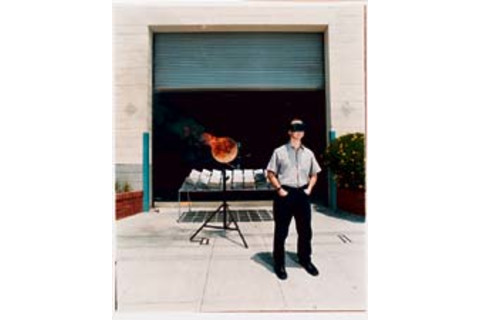
At Idealab in Pasadena, California, a mirror array focuses scattered sunlight at a single point, producing enough heat to set a block of wood ablaze instantly. The revolutionary new solar power device uses the heat to drive a Stirling engine and an electrical generator. "We're aiming for a system that completely pays for itself in a few years," inventor Bill Gross says, wearing welding goggles to shield his eyes from the light. "After that you've got free electricity."
The Sunflower worked, but Gross wasn't satisfied. It did not have quite enough mirror area, so it didn't produce quite enough heat and hence electricity in relation to its cost. Gross and his team went back to the drawing board. In a few months, he says, his team will roll out a reconfigured system with more mirrored surfaces that can achieve what he calls the Holy Grail—power that costs only a dollar a watt. Gross estimates that he can mass-produce the gadget, which is capable of generating 250 peak watts of power, for sale at $250 a unit. At one dollar per peak watt, the power from solar electric generators could compete with power from the national grid. Forty of the devices would produce as much electricity as one of the Sandia labs dishes but at one-fifth the cost. Rich Diver, the head of the solar team at Sandia, says he's impressed: "In principle, this could work. They're talking about using common materials, not something like purified silicon and lots of conductors, like you'd need for photovoltaics. I'm going to stay skeptical until I see their data, but if they do pull it off, it would be huge. It could change the world."
Evolution of a Solar Dish Bill Gross and his colleagues at Idealab set out to create a solar power device based on a simple principle that anyone can prove with a magnifying glass or mirror: Focusing the rays of the sun generates searing heat. The final design was shaped by a number of engineering and cost challenges:

A: Industrial designer Nathan Allen (back to camera) sets up a six-foot parabolic reference mirror that focuses scattered sunlight into a beam directed at a Stirling engine, which in turn drives an electric generator. A cart to the left of the dish contains equipment that test engineer Matthew Schneider uses to measure the engine's operating properties, including its running speed, internal pressure, electrical output, and the temperature of the hot cup.
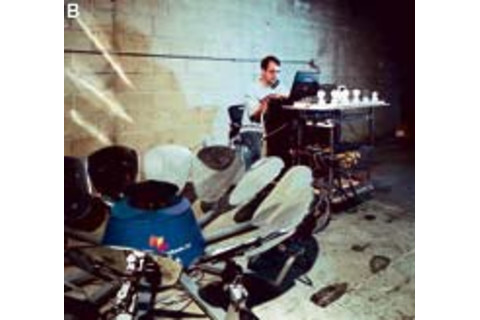
B: The team's main objective was to create a compact solar collector that would follow the path of the sun across the sky. The Sunflower prototype featured 12 petal-like mirrors that fanned out in a six-foot-wide array. The array lay flat enough to fit neatly under a clear plastic dome designed to protect it from wind and inclement weather. Two dozen small stepper motors linked to sensors on a hot cup at the center of the array allowed the device to track the sun from sunrise to sunset. Here Schneider measures temperature readings from thermocouples on the hot cup. Ultimately, the team was dissatisfied with the amount of sunlight the petals reflected compared with the original parabolic dish. They considered enlarging the individual petals or adding a second row but ruled out both options as unwieldy.
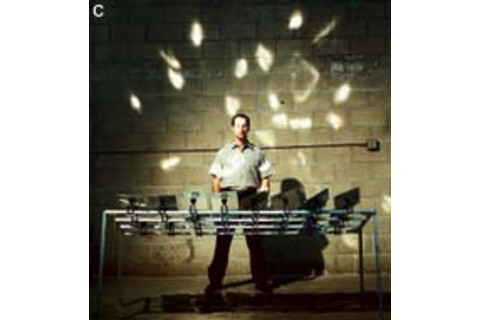
C: Gross examines a mirror array for the final design, which the team calls a heliostat. The heliostat combines three of these arrays in a 6-by-9-foot panel, 10 inches high, with 96 partial parabolas. The mirrors, set side by side in columns and rows, all beam their heat to a single focal point. Six computer-directed stepper motors, linked to light-sensing photocells and heat-sensing thermocouples, adjust the orientation of the mirrors as the sun moves across the sky.
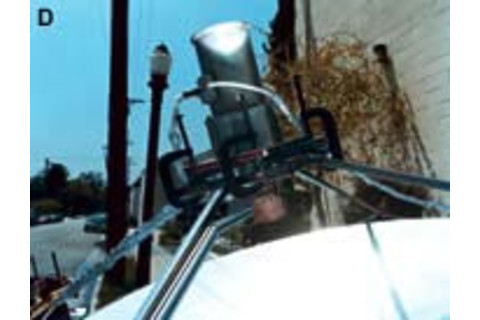
D: Heat rays from the mirrors converge precisely on a hot cup on the bottom of a Stirling engine, suspended two to four feet above the mirror array. As the temperature rises, a pocket of hot air inside the Stirling engine expands, driving a piston. Thin, stainless-steel fins lining the cylinder temporarily absorb heat, cooling air in the pocket as the piston moves. When the piston reaches the top of the engine, a second piston, mechanically linked to the first, pushes the cooled air back toward the hot cup. The cycle repeats. Meanwhile, the first piston turns a conventional generator, producing 250 watts of electricity.
Gross calls himself a serial entrepreneur. He started young, buying candy wholesale and selling it to other kids at a markup. By the time he finished high school in 1976, he had earned enough money to pay for his first year at Caltech. He did it by placing an ad in the classifieds at the back of Popular Science, offering a book and trigonometric charts to help hobbyists build solar mirrors. In his sophomore year, he invented and patented a new stereo speaker, which helped cover the rest of his college expenses. The speaker company he founded eventually turned to developing software, such as the legendary artificial intelligence program Hal, and was purchased in 1986 by Lotus. In 1991, unimpressed with the educational software available to his kindergarten-age son, Gross started Knowledge Adventure. When he sold Knowledge Adventure five years later for $100 million, it was the third largest educational software company in the world. In 1996 Gross founded Idealab and set out to conquer the World Wide Web. The company is headquartered in a low white-brick building in Pasadena's trendy Old Town district. Inside, little wheeled robots wander about, and traffic signs proclaim "Droid Crossing." No one at Idealab has a real desk. Everyone, from the lowliest technician to the president, gets a plain door from Home Depot, laid flat on two filing cabinets. The ceiling is open to the rafters, and employees work at pods of office carrels, each a little company being born. The pods are collectively arranged like a solar system, with Gross as the sun. Idealab rode the dotcom bubble all the way. When the bubble imploded, many Idealab ventures—most notably the high-flying eToys.com—flamed out, and the company slashed its workforce in half. Some companies it incubated thrive to this day, including CarsDirect, for buying automobiles on the Web, and the search service Overture. Inspiration still flows, but the emphasis has turned from software to hardware. "Robots, we've got to do robots," Gross announced in 2001 during a frantic phone call to headquarters while flying in a commercial jet. So now, one Idealab pod is building Evolution Robotics. Another pod is developing hyper-speed, sub-infrared optical networking systems; yet another is reinventing machines that inspect microchips. The pod next to Gross's office is the home of Energy Innovations, the team in charge of developing and marketing a new solar dish.
In Idealab's small fabrication shop, Gross fondles a gleaming steel cylinder the size of a large thermos bottle as he explains why the Stirling engine it comes from is the key to the solar-dish project. Robert Stirling, a Scottish minister, designed the original engine in 1816 as an alternative to the steam engine. For nearly two centuries, the Stirling engine has been a source of endless fascination to hobbyists but of little practical use. In high school Gross took metal shop just to learn how to build one. The engine is both simple and clever. Heat applied to a sealed chamber on one side of the engine causes air to expand and push a piston. As the piston moves, the air flows to the cold side of the engine and cools down. A second piston nudges the cooled air back to the hot side to restart the cycle. Part of the engine's great efficiency lies in how a device called a regenerator can store and recycle part of the thermal energy that would ordinarily be lost as the air cools. The benchmark for Stirling engine design, in Gross's view, was established by the Dutch manufacturing conglomerate Philips just after World War II. General Motors later refined the design, but neither company ever produced a marketable engine. "The Philips engine was a beautiful, beautiful piece of engineering, a real work of art," says Gross. "But it would have cost us $50,000 to build. I wanted to find a way to make it for $100." Because the energy from the sun would be free, says Gross, "we didn't need to build the most efficient Stirling engine ever made. We just needed the best performance at the lowest cost." Gross soon realized that to achieve that goal, "we needed to look at something like a trillion variations. And that was going to take us decades." A solution came by way of Charles Darwin. More than 30 years ago, John Holland of the University of Michigan showed that computers could use what he called genetic algorithms to solve complex problems. Working the way Darwin said nature works—selecting for traits that assure survival—a computer model could use an algorithm to test thousands of permutations of any design. So the Idealab team developed a Stirling engine algorithm that selected for one simple idea: the most watts produced per dollar invested. The first computer run began with 100 designs for a Stirling engine. The design elements of the engines were chosen entirely at random. The program then selected the two designs with the best cost-to-efficiency ratio. "Then," says Gross cheerfully, "We let the top two have sex." The next run of 100 designs included the previous two "parents," a third design that included a 50-50 blend of traits from both parents, and 93 genetic mutations—new designs with a mix of parental traits and new traits. A standard desktop computer, using Idealab's software to winnow out 100,000 combinations overnight, could reach conclusions in a few hours. Last year the team settled on a design that is half as efficient as the Philips Stirling engine but can be manufactured for roughly $100.
Halfway through a workday, Gross and key members of the solar team gather at a nearby Italian bistro. This is a drill they've got down pat. Team members bring notebooks, calculators, and sketch pads, and Gross picks up the tab. At the table are chief designer Gregg Luconi, engineering director Denes Zsolnay, consultant Kurt Jechel, industrial designer Nathan Allen, and marketing wiz Steve Chadima. Hardly any food at all finds its way into Gross's mouth during the session because he talks nonstop, like an auctioneer. He dashes off diagrams in thin air with his hands and puts some of them down on his tablet. He serves as an instantly referenced catalog of every detail, from the physical limits of the nonstick coating on a gasket to the bulk cost of screws. The arrangement of mirrors in the dish quickly becomes the main topic. The decision to create an array of small mirrors solved one major design problem. It meant the solar dish could be compact, ensuring that it would rise no more than a few inches from the rooftop of a house and could be protected from wind and weather under glass or plastic. But now, only five weeks from the deadline for rolling out a final design, Gross still isn't sure whether the daisy-petal arrangement of mirrors will produce an optimal amount of heat. Besides, he is obsessed with costs—every dollar matters. As designed, the Sunflower would require two stepper motors to position each petal: 24 motors for 12 petals, $24 dollars at bulk. Suppose we reconfigure the array, Gross muses. Could we find a way to link several mirrors mechanically and use fewer motors? That leads to talk of an alternative design. Maybe it shouldn't look like a flower. Maybe it should look like an egg crate. An arrangement of mirrors in closely spaced rows and columns might punch up the reflected heat and might require fewer motors. Across the long table, scribbling furiously on his pad, Luconi drafts a sketch of what it might look like. Later that night, he will e-mail Gross a full-color 3-D rendering. But what about abandoning multiple smaller mirrors altogether? Gross wonders out loud about going back to a simple round dish like the one Luconi and Zsolnay had been experimenting with earlier. Although a single large dish would be the most heat-efficient design, its normal upright posture would make it vulnerable to wind and weather. What if the team laid it more or less flat and put rollers on it? He dumps his bread on the table so he can use the plate to show how it might work. And, oh—what about dropping the heat idea too? Some cutting-edge solar photovoltaic materials, mainly used on satellites in the past, respond to intensified light by producing more electricity. Although these materials are expensive, Gross now wonders what would happen if his team used sun-amplifying mirrors to blast them with, say, the light of 400 suns. The photovoltaic cells might begin to falter in the blast of fierce heat that accompanied the light. But how about slicing these chips small enough to equip each one with an off-the-shelf heat sink already available for microprocessors? Under the light of 400 suns focused by the team's mirrors, maybe these chips could spew out electricity for a dollar a watt. The Holy Grail! We can test that, Gross says. And we can keep working on the egg crate. Then he is out the door, off for a meeting with the robot guys. Most of a chicken remains uneaten on his abandoned plate.
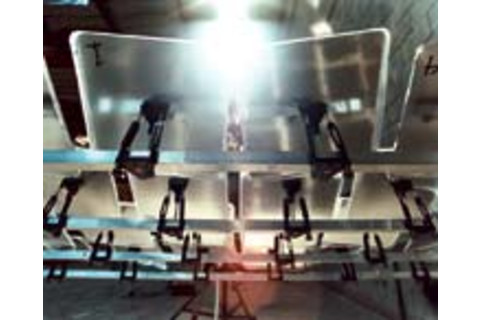
The mount for each eight-inch-wide mirror in a heliostat—a prototype solar collector—features a pair of screw-driven gears. In an operational heliostat, paired motors will travel under the mirror array, nudging each screw gear once a minute to keep the individual mirrors aimed precisely at the sun.
A month later, on schedule, the solar team settles on a design. They're staying with the heat idea and the egg crate. It will feature 96 little 8-inch mirrors, arranged in a 10-inch-high rectangular box, protected by a flattened dome of clear plastic, a Whitman's Sampler of mirrors. The 96 mirrors will be moved by six stepper motors that run a complex of screw-driven gears. Photo sensors will track the sun, and temperature-sensing thermocouples on the Stirling engine's hot cup will fine-tune the direction in which the mirrors will point. The team thought that something with the words egg crate in it would sound undignified, so they called it the heliostat. Each heliostat measures 6 by 9 feet and produces 250 peak watts of electricity. Initially Idealab will market the device for commercial buildings, where platoons of heliostats could be wired together on flat roofs. A typical energy-hungry American house would need between four to eight units. In two or three years, with production runs of 100,000 heliostats, the cost to the consumer should decline to one dollar a watt. "Oil and other fossil-fuel industries have such huge efficiencies that it's been incredibly difficult for solar to compete," Gross says. "But we're about to do it, and merely by rearranging some basic materials like mirrors and stainless steel."
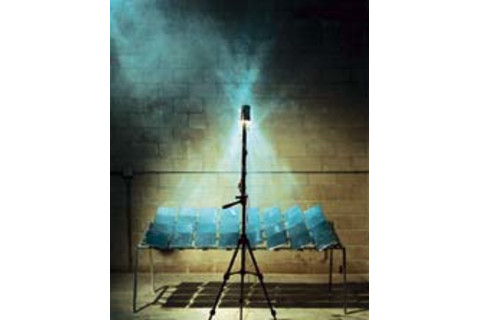
Smoke reveals the mirror magic of the heliostat solar collector. Sunlight hits each of the partial parabolic mirrors in the array and reflects onto a single focal point, delivering some 1,200 degrees Fahrenheit of heat to a stainless-steel hot cup. In a working heliostat, the hot cup will be attached to a Stirling engine.

Energy Innovations' Web site has information about their solar-powered Stirling engine: www.energyinnovations.com.
At the Idealab site, learn more about Bill Gross's dotcom ventures, past and current, as well as the company's other high-technology projects: www.idealab.com.
Sandia National Laboratories is conducting some solar thermal energy projects. Read about them—and see some striking photos—on their site: www.sandia.gov.
The Kramer Junction Company (KJC) operates a utility-scale solar array in the Mojave Desert and sells power to Southern California Edison. See photos of their projects at www.kjcsolar.com.
Learn how Stirling engines work, complete with animated diagrams and a discussion about why the Stirling engine is in only limited use today: www.howstuffworks.com/stirling-engine.htm.
The American Stirling Store is the place to go for Stirling aficionados. Buy a coffee-cup Stirling engine, learn more about the technology, or join a discussion group of like-minded Stirling fans: www.americanstirling.com.


